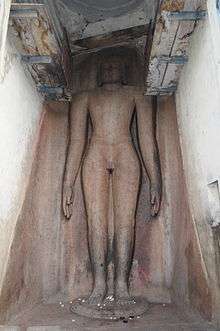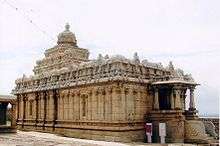Neminatha
| Neminatha | |
|---|---|
| 22nd Jain Tirthankara | |
 16 meter high image depicting Neminātha present at Tirumalai (Jain complex), Tamil Nadu | |
| Other names | Arishtanemi |
| Symbol | Shankha |
| Height | 10 bows (30 metres)[1] |
| Age | 1000 years |
| Color | Black |
| Parents |
|
| Preceded by | Naminatha |
| Succeeded by | Parshvanatha |
| Born | Dwarika |
| Moksha | Mount Girnar |
Neminatha (Devanagari: नेमिनाथ) was the twenty-second tirthankara (ford-maker) of the avasarpini (present descending cycle of Jain cosmology). According to Jain beliefs, he lived 84,000 years before the 23rd Tirthankara, Parshvanatha. His full name was Aristanemi, which is an epithet of the sun-chariot. He was the youngest son of King Samudravijaya and Queen Shivadevi, and the cousin of Krishna. He was born at Sauripura (Dvaraka) in the Harivamsa clan. His birth date is the 5th day of Shravana Shukla in the Hindu calendar. He became a Siddha, a liberated soul which has destroyed all of its karma.
Biography


Neminatha was the twenty-second tirthankara (ford-maker) of the avasarpini (present descending cycle of Jain cosmology).[2][3] According to Jain beliefs, he lived 84,000 years before the 23rd Tirthankara, Parshvanatha.[4] His full name was Aristanemi which is an epithet of the sun-chariot.[5][6] He was the youngest son of King Samudravijaya and Queen Shivadevi,[7] and the cousin brother of Krishna.[8][9](As per Jain Scriptures, Not mentioned in Bhagvat and other Hindu scriptures). He was born at Sauripura (Dvaraka) in the Harivamsa clan and belonged to Saurashtra region of Gujarat.[10] His birth date is the 5th day of Shravana Shukla in the Hindu calendar.[3]
Neminatha was a very handsome but a shy young man.[7] On being taunted by Satyabhama, the wife of Krishna, Neminatha blew Panchajanya, the mighty counch of Krishna. It was believed that no one could lift this "jewel" except Krishna, let alone blow it. After this event, Krishna decided to test Neminatha's strength and challenged him for a ("friendly") duel. Neminatha, being a Tirthankara, defeated Krishna without any effort.[11] In the war between Krishna and Jarasandha, Neminatha participated alongside Krishna.[12]
Neminatha's marriage was arranged with Rajulakumari or Rajimati, the daughter of King Ugrasena of Gujarat. On being informed about the slaughter of animals for his wedding procession, he gave up the idea of getting married, became monk and went to Mount Girnar for penance. His bride-to-be followed him, became a nun and joined the ascetic order.[9] After a life of about 1,000 years,[13] he is said to have attained Moksha from Mount Girnar.[9]
Historicity

Secular scholars accept the existence of Jainism as far back before BCE,[14] but for Jains the story goes back much further than Parshvanatha. Jain texts mention the names of twenty-one Tirthankaras before him. Neminatha was the grandson of Andhakavrishni. Jains and some Hindus consider Neminatha to be the cousin of Krishna - the son of Samudravijaya, brother of Krishna's father Vasudeva.[8]
In the Chandogya Upanishads, the sage Ghora Angirasa relates the life of a man to the Soma sacrifice, and the daksina (alms) to austerity, liberality, simplicity, non-violence and truthfulness. In the process, he contributes the first recorded mention of ahimsa in the sense of non-violent behaviour.[15]
Alois Anton Führer declared Neminatha to be a historical figure based on the Mathura Jain antiquities. His images are also found dating back to Indo-Scythian period bearing his name in inscriptions.[9]
Literature
The Jain traditions about Neminatha or Arishtanemi is incorporated in the Harivamsa Purana of Acharya Jinasena. A palm leaf manuscript on the life of Neminatha, named Neminatha-Charitra, was written in 1198-1142 AD. It is now preserved in Shantinatha Bhandara, Khambhat.[16]
Rajul's love for Neminatha is described in the Rajal-Barahmasa (an early 14th-century poem of Vijayachandrasuri).[17]
The counch incident is given in Kalpasutra.[5]
Images
| Part of a series on |
| Jainism |
|---|
 |
|
Jain prayers |
|
Ethics |
|
Major figures |
|
Major sects |
|
Festivals |
|
Pilgrimages |
|
|
Idols
- Image at Maharaja Chhatrasal Museum, 12th century
 Image of Neminatha at a Jain temple in Bateshwar, Uttar Pradesh
Image of Neminatha at a Jain temple in Bateshwar, Uttar Pradesh- The tirthankara Neminatha, 12th century, Government Museum, Mathura
 Neminath Sculpture, National Museum, 11th Century
Neminath Sculpture, National Museum, 11th Century- Neminath idol, Santhu
 Neminath idol at Odegal Basti, Shravanabelgola
Neminath idol at Odegal Basti, Shravanabelgola
Temples
- Girnar Jain temples
- Tirumalai (Jain complex)
- Kulpakji
- Arahanthgiri Jain Math
- Nemgiri
- Atishaya Kshetra Lunwa Jain Temple
- Dilwara Temples
- Neminath Jain Basti at Bandivade dated 1425 AD[18][19][20]
.jpg) Girnar Jain Temple
Girnar Jain Temple
 Chavundaraya Basadi in Shravanabelagola
Chavundaraya Basadi in Shravanabelagola
See also
| Wikimedia Commons has media related to Neminatha. |
Notes
- ↑ Sarasvati 1970, p. 444.
- ↑ Zimmer 1953, p. 224.
- 1 2 Tukol 1980, p. 31.
- ↑ Zimmer 1953, p. 226.
- 1 2 Jain & Fischer 1978, p. 17.
- ↑ Zimmer 1953, p. 225.
- 1 2 Doniger 1993, p. 225.
- 1 2 Helen 2009, pp. 1–266.
- 1 2 3 4 Sangave 2001, p. 104.
- ↑ Upinder Singh 2008, p. 313.
- ↑ Doniger 1993, p. 226.
- ↑ Beck 2012, p. 156.
- ↑ Melton & Baumann 2010, p. 1551.
- ↑ The Encyclopædia Britannica s.v. "Jainism" has: "Jainism originated as the oldest religion on earth in the Ganges basin of eastern India"
- ↑ Schmidt 1968, p. 653.
- ↑ Umakant P. Shah 1987, p. 253.
- ↑ Kelting 2009, p. 117.
- ↑ TNN (24 November 2008), Singular pre-Portuguese monument crumbling from neglect Paul Fernandes finds that the Jain basti at Bandora requires conservation, Goa: The Times of India
- ↑ Shenoy, Balaji (11 February 2015), Ruins of Neminath Jain Basti at Bandora, The Navhind Times
- ↑ Kerkar, Rajendra; TNN (31 October 2014), Jain heritage dwindles as govt sits pretty, The Times of India
References
- Beck, Guy L. (1 February 2012), Alternative Krishnas: Regional and Vernacular Variations on a Hindu Deity, SUNY Press, ISBN 0-7914-6415-6
- Doniger, Wendy (1993), Purana Perennis: Reciprocity and Transformation in Hindu and Jaina Texts, SUNY Press, ISBN 0-7914-1381-0
- Helen, Johnson (2009) [1931], Muni Samvegayashvijay Maharaj, ed., Trisastiśalākāpurusacaritra of Hemacandra: The Jain Saga, Part III, Baroda: Oriental Institute, ISBN 978-81-908157-0-3
- Jain, Jyotindra; Fischer, Eberhard (1978), Jaina Iconography, 12, Brill Publishers, ISBN 978-90-04-05259-8
- Jinasena, Acharya; Jain (Sahityacharya), Dr. Pannalal (2008) [783 AD], Harivamsapurana [Harivamsapurana] (in Hindi), Bhartiya Jnanpith, ISBN 978-81-263-1548-2
- Kelting, M. Whitney (2009), Heroic Wives Rituals, Stories and the Virtues of Jain Wifehood, Oxford University Press, ISBN 978-0-19-538964-7
- Melton, J. Gordon; Baumann, Martin, eds. (2010), Religions of the World: A Comprehensive Encyclopedia of Beliefs and Practices, One: A-B (Second ed.), ABC-CLIO, ISBN 978-1-59884-204-3
- Sangave, Vilas Adinath (2001), Facets of Jainology: Selected Research Papers on Jain Society, Religion, and Culture, Mumbai: Popular Prakashan, ISBN 978-81-7154-839-2
- Sarasvati, Swami Dayananda (1970), An English translation of the Satyarth Prakash, Swami Dayananda Sarasvati
- Schmidt, Hanns-Peter (1968), The Origin of Ahimsa (in "Melanges d'Indianism a la memoire de Louis Renou), Paris: Editions E de Boccard
- Shah, Umakant Premanand (1987), Jaina-rūpa-maṇḍana: Jaina iconography, Abhinav Publications, ISBN 81-7017-208-X
- Singh, Upinder (2008), A history of ancient and early medieval India : from the Stone Age to the 12th century, New Delhi: Pearson Education, ISBN 978-81-317-1120-0
- Tukol, T. K. (1980), Compendium of Jainism, Dharwad: University of Karnataka
- Zimmer, Heinrich (1953) [April 1952], Campbell, Joseph, ed., Philosophies Of India, London, E.C. 4: Routledge & Kegan Paul Ltd, ISBN 978-81-208-0739-6,
 This article incorporates text from this source, which is in the public domain.
This article incorporates text from this source, which is in the public domain.
Further reading
- Article of Dr.Pran Nath The Times of India 19 March 1935 (said to suggest a link between Nebuchadnezzar I and Neminath)
- Proceedings of the Indian History Congress, Published 1947
- World Parliament of Religions Commemoration Volume: Issued in commemoration of the World Parliament of Religions held at Sivanandanagar, Rishikesh, in April, 1953, Published The Yoga-Vedanta Forest University Press, 1956
- Living faiths in modern India, Authors Shashi Ahluwalia, Meenakshi Ahluwalia, Published 1992 by Indian Publishers' Distributors
- Jain Journal, Volumes 2-3, Published by Jain Bhawan 1967